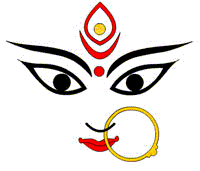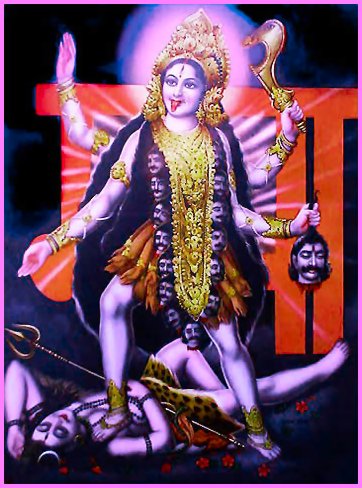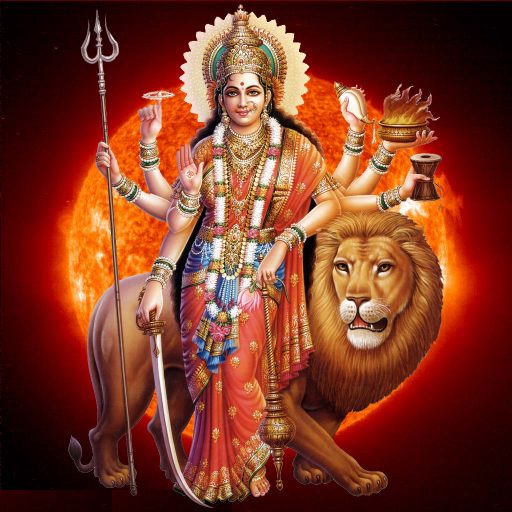
Shakti Maa
Cosmic Energy in its dynamic form is symbolized for us ordinary mortal in the form of Shakti, the World Mother, who is the power and energy by which the Great God creates, preserves and destroys the world. She is shown in many forms. As Uma or Parvati, she is the gentle consort of Shiva.
As Kamakhi or Rajarajeshwari, she is the Great Mother. In one hand she holds a noose, signifying worldly attachments from which we should free ourselves. The hook in her other hand is indicative of her prodding us on to the path of righteousness. The sugarcane plant she carries is a symbol of the sweetness of the Mind. The arrows she holds in one hand are our five sense-perceptions which we have to conquer.
In the form of Durga she rides the tiger, the ego and arrogance that Man has to subdue. With the weapons in her hands she fights the eight evils(hate, greed, passion, vanity, contempt of others, envy, jealousy and the illusions with which man binds himself).

Hindu Power Goddess – Kali Maa
In her angry form She is known as Kali, the personification of Time. In this frightening form she destroys Mahishasura (the demon buffalo) who is the symbol of ignorance which is man’s greatest enemy. Her arms and weapons are constantly flaying and fighting evil in all forms. The skulls she wears tell you that Man is mortal. Her dark form is symbolic of the future which is beyond our knowledge, and as Kali she tells you that Time (Kala) is immutable and all-powerful in the Universe. Not only is the Shakti responsible for creation, it is also the agent of all change. Shakti is cosmic existence as well as liberation, its most significant form being the Kundalini Shakti, a mysterious psychospiritual force. Shakti exists in a state of svatantrya, dependence on no-one, being interdependent with the entire universe.

Shakti Maa Mother Goddess Durga
In Shaktism, Shakti is worshiped as the Supreme Being. However, in other Hindu traditions of Shaivism and Vaishnavism, Shakti embodies the active feminine energy Prakriti of Purusha, who is Vishnu in Vaishnavism or Shiva in Shaivism. Vishnu’s female counterpart is called Lakshmi, with Parvati being the female half of Shiva.
There are 4 Adi Shakti Pitha and 51 important centers of Shakti worship located in the Indian sub-continent, which are located in India, Sri Lanka, Nepal, Bangladesh, Tibet and Pakistan. These are called Shakti Peethas. Most Shakti peethas have since developed into famous temple complexes, including: Jwalaji (Himachal), Tara Tarini Berhampur, Orissa, Katyayani (Chattarpur, Delhi), Kamakhya (Assam), Naina Devi (Himachal), Manasa devi (Chandigarh).
Main pithas in are Tuljapur(Jagdamba), Kolhapur(Mahlaxmi), Vani-Nashik(Sptashrungi), Mahurgad(Renukamata)
Maa Mahakali literally translated as Great Kali, is sometimes considered as a greater form of Kali, identified with the Ultimate reality of Brahman. It can also simply be used as an honorific of the Goddess Kali, signifying her greatness by the prefix “Mahā-“. Mahakali, in Sanskrit, is etymologically the feminized variant of Mahakala or Great Time (which is interpreted also as Death), an epithet of the God Shiva in Hinduism. Mahakali is the presiding Goddess of the first episode of the Devi Mahatmya. Here she is depicted as Devi in her universal form as Shakti. Here Devi serves as the agent who allows the cosmic order to be restored.